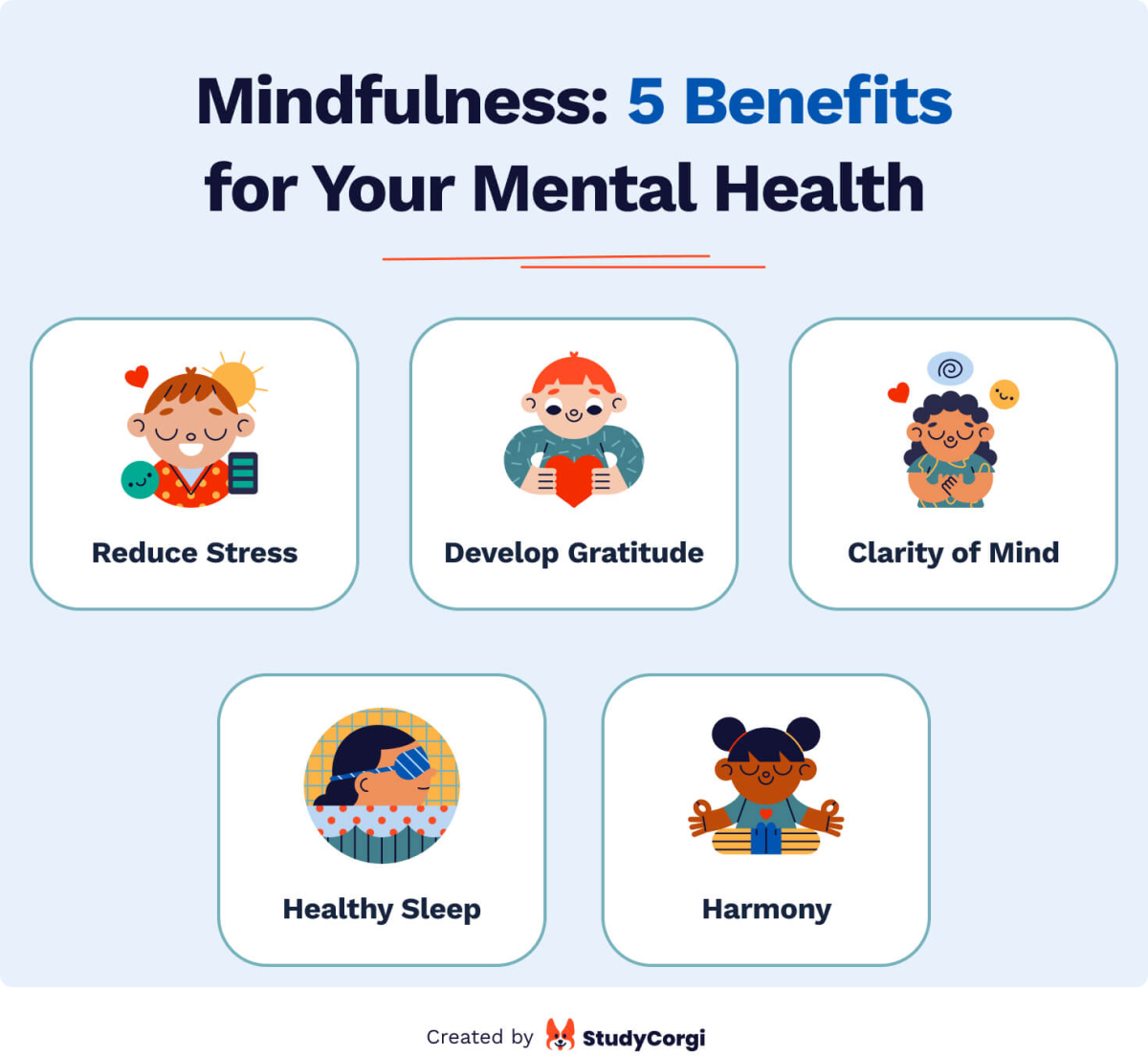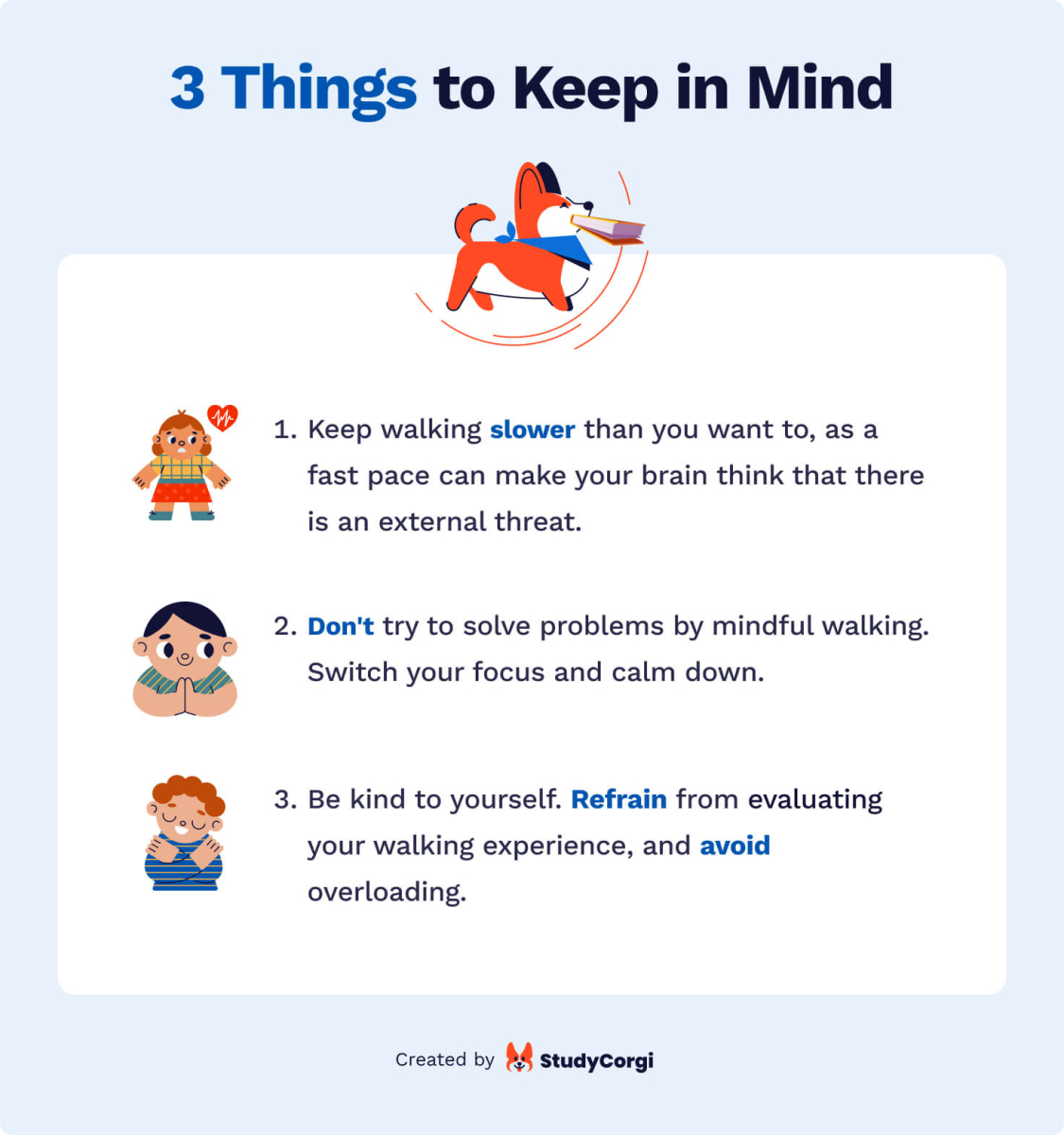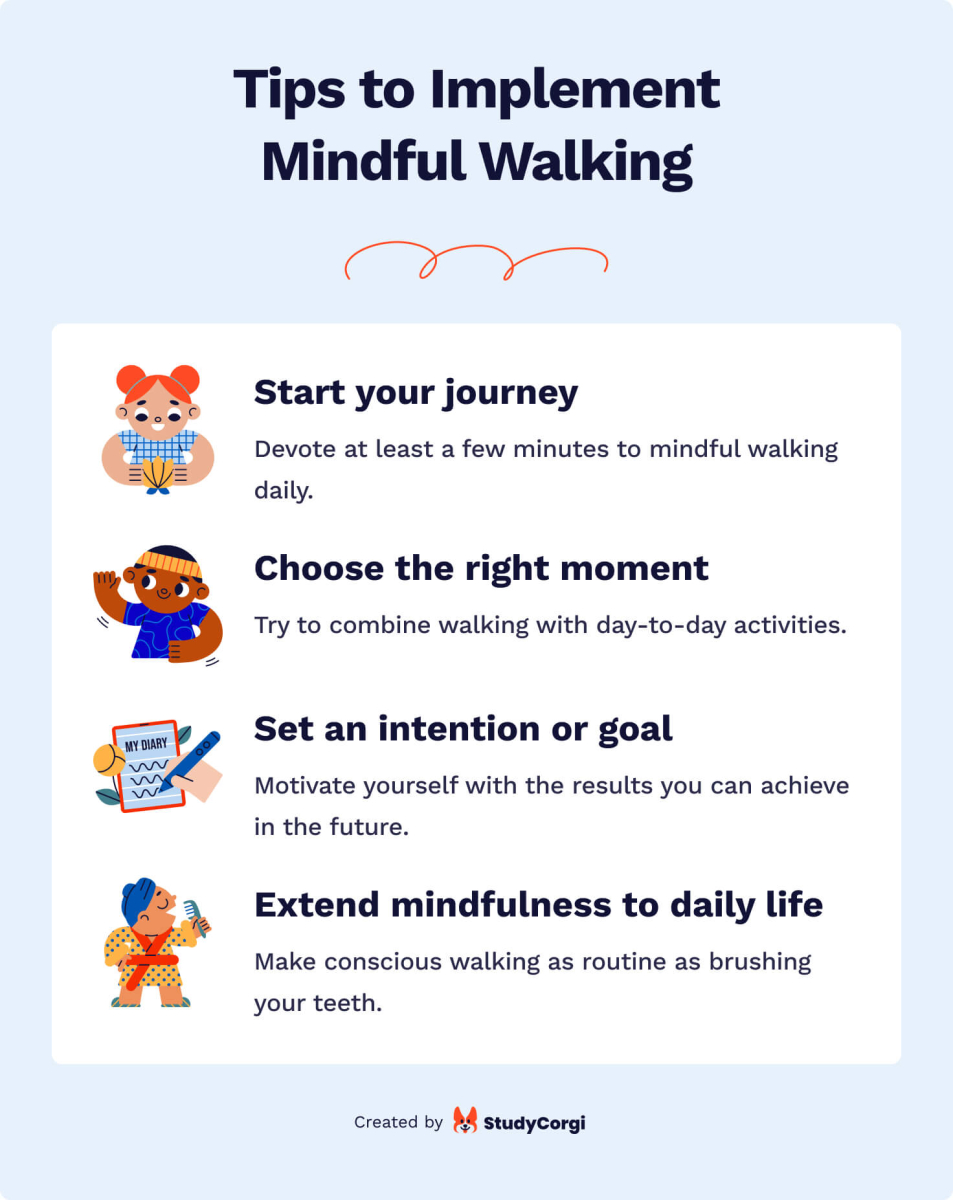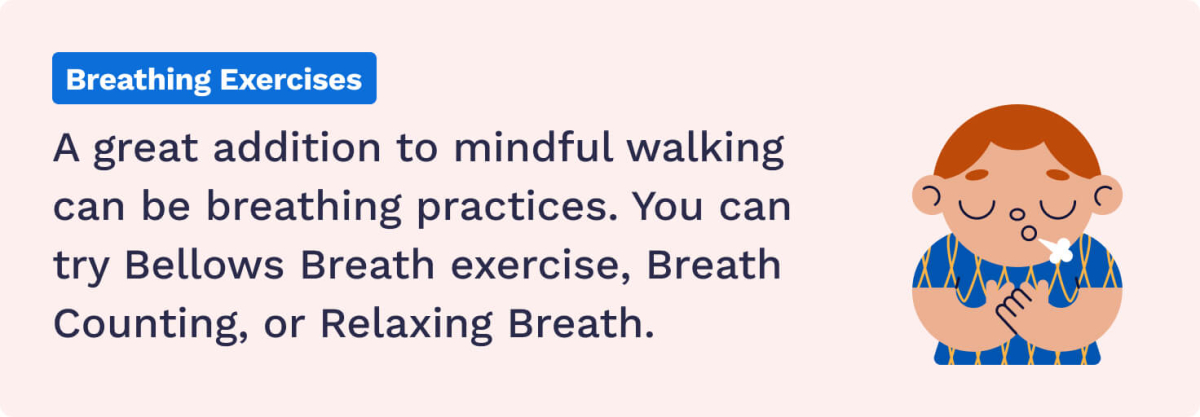Walking is often perceived as a routine activity for getting from one place to another when you can’t use a car, bike, or public transportation. However, with the right approach, a simple walk can become a fantastic tool for self-discovery, inner peace, and respite for body and soul. Our team has prepared an extensive guide explaining everything you should know about mindful walking and how to implement it into your life.
Mindful walking is an opportunity to bring awareness to your daily activities. You master how to stay in the current moment and appreciate your journey rather than focusing on your destination. It can be practiced anywhere, from a path in the woods to a busy street. Mindfulness allows you to find joy and beauty in the simplest things, like the flutter of leaves or the sparkle of dew on the grass. In this way, even a casual walk to the supermarket allows you to reduce stress and relax during a hard and busy day at college. This simple technique can drastically improve your quality of life!
🚶 What Is Mindful Walking?
Mindfulness is a meditation practice in which you seek to become conscious of your physical and inner states. You listen to your feelings, emotions, and thoughts. It helps you realize how beautiful it is to live here and now, enjoying minor events and accomplishments.
Mindful walking is a part of consciousness development and a great example of mindfulness practice. It’s an activity that can help you feel less stressed and exhausted by your daily responsibilities, challenging projects, or your academic workload at university. We often forget to prioritize our mental health. Incorporating a walking practice can help you delight in the present moment and relish that you are alive and deserve happiness and wellness.
Benefits for Your Mental Health
Taking care of your mental well-being and emotional state is as vital as your physical health – they go hand in hand. Giving equal attention to both improve your mood and motivation, making you healthier overall. This allows you to excel in your studies, makes passing exams more manageable, and eliminates writer’s block. Mindful walking is an excellent way to tend to your mental and physical states.

In this section, we will cover the positive sides of this practice:
- Reducing stress and anxiety levels.
Fresh air and reconnecting with nature bring you harmony. After just two weeks of regular practice, you’ll feel calmer and more balanced. It will be easier for you to handle criticism at university or work. You will have fewer anxious thoughts and be more comfortable with schoolwork. - Developing a sense of gratitude.
A sense of gratitude helps you appreciate yourself and your surroundings. Ultimately, this practice enhances your confidence, mood, and well-being. - Clarity of mind.
During mindful walking, you can spend time alone without the stress of informational noise, assignments, social networks, worries, or fears. You let yourself slow down and feel the moment, live it for real, without reflecting on your week’s to-do list. Once you return to the daily grind, you will find concentrating on your chores and studies easier. - Enhance the quality of your sleep.
Taking the time to walk before bed will relax you mentally and physically. It will help you regulate your body’s energy levels and tire yourself out. You’ll enjoy a more effortless switch from a busy day to a calm evening and develop sleep hygiene. - Creating a mind-body connection.
Mindful walking involves fully understanding your body movements, sensations, and environment. You can develop a mind-body connection by focusing on your breath, steps, and the present moment. Likewise, you will become more attentive to your body’s signals and better recognize and eliminate discomfort or tension.
✨ Find Your Motivation to Try Mindful Walking
Some people hesitate to try mindful walking because of a lack of motivation. Here are some insights to spark motivation:
- Knowing your body.
As you walk mindfully, pay attention. Your body tells your whole story. Focus on elements such as your posture, walking pace, and the stiffness of your movements. Becoming in tune with your body will help you feel and love it better. - Improving your ability to concentrate.
Unlike meditation at home, mindful walking can involve many distractions, such as different sounds and smells around you. Each one fights for your attention, and you can distract yourself from meditation. Over time, with practice, you will be better able to stay in the present moment enhance your productivity. - Increasing blood flow.
Most of us live a sedentary lifestyle. When we spend time at home, office, or college, most of the time, we are sitting. This adversely affects our blood flow. Walking is an easy way to boost physical well-being and energy levels. It is crucial for physical and mental health.

- Adding mindfulness to your everyday.
The longer you practice, the better you get at any activity. Meditation can be practiced at any convenient time, with no time limit. Mindfulness can be exercised in many areas of your life and, over time, become a lifestyle. - Gaining inspiration.
Awareness puts everything in its place. Over time, you will develop and gain a sense of clarity. You can use this state of inner peace to stimulate creativity. - Enhancing digestion and overall wellness.
Walking after a meal helps your body relax and activates your digestive processes. It helps avoid congestion, positively affects sugar levels, and warms up your muscles. - Bringing joy to your life.
Even if you’re already a fitness enthusiast, it’s a good idea to incorporate mindful walking into your daily routine. This practice helps you tune in to your internal sensations.
Best Time to Practice
You should find a quiet, safe, and comfortable place to begin your practice. Ideally, it should be somewhere you can be alone in nature. However, as you develop the ability to concentrate, you’ll be able to practice mindfulness in any space. This could be anything from a busy street to a grocery store. There are no boundaries to the things you can do!
Places for Mindful Walking
Here are key places you can try walking consciously:
🌄 9 Steps for Preparing Yourself
Meditation and mindfulness while walking do not need special equipment or training. We’ve outlined some simple steps to help get you started:
- Make sure the place where you practice mindfulness is safe and comfortable.
- Wear comfortable shoes and clothing so your movements are not constrained as you walk.
- Focus on your sensations and try to be aware of them.
- Find balance, take care of your posture, and release muscle tension.
- Focus on your breathing; take a few deep inhales.
- Try to stay in the present. However, be prepared that your mind may periodically wander, and that’s OK.
- Tune in to positive feelings. Feel free to smile if you are genuinely happy about something.
- Try pausing and closing your eyes periodically to be more aware of your other senses.
- Enjoy relaxing music or a podcast to improve your experience.
🌱 3 Techniques for Practicing Mindfulness
Here we suggest some of the most fruitful methods for improving mindfulness. Try to spend time on this rewarding hobby, it will bring you happiness.

Walking Meditation Practice
Walking meditation is different from mindful walking. This approach to mindfulness may work better for you, so why not give it a try? To practice walking meditation, you should:
📌 Select a path. Find a suitable quiet place without obstacles. A lane of about 10 to 20 steps is enough. A small stretch of road will help you concentrate not on the destination but on the process itself.
📌 Begin moving. Start by focusing on your physical sensations. Pay attention to your feet; feel how your feet stretch during each step and how your muscles move.
📌 Focus properly. You will encounter intrusive thoughts. Accept those thoughts and worries. Stay calm and balanced, and allow yourself to return to meditation.
📌 Pause. Each time you reach the end of your path, you should pause for a moment and only then turn around and continue.
📌 Practice patience. Your success here lies in regular practice, diligence, patient self-love, and gratitude.
Mindful Walking Practice
Here we explain how to undertake a mindful walking practice, following the Jillian Pranksy method:
📌 Place to walk. Choose a location where you can feel relaxed and confident. Keep in mind, it is recommended to pick a quiet site. Doing so is necessary to minimize irritants and potential distractions.
📌 Release tension. Straighten up and stand to your full height with your feet flat. Take several deep breaths and relieve the pressure on your shoulders and neck.
📌 Tune in. Be aware of yourself and your body. Start walking and watch your movements. Pay attention to the fact that your breathing is even and calm.
📌 Concentrate on your sensations. There is no need to focus on anything in particular; just alternately engage your different senses and become aware of yourself in that environment. Afterward, try to disperse your attention and immerse yourself in your environment.
📌 Stay calm. If you begin to have thoughts that disrupt your focus, keep walking. Try to redirect your attention to your steps or breathing. When you start to calm down again, repeat the mantra, ‘I am tranquility,’ while controlling your breathing. Continue this practice for at least 10 to 15 minutes, or longer if you wish.
Use Your 5 Senses for Mindful Walking
Explore your consciousness by asking yourself the following:
💡 Tips to Implement Mindful Walking into Your Life
We realize fitting a new activity into your busy schedule is challenging. Below you will find some great suggestions you can use to make walking a regular and healthy habit!

- Start small. Start by devoting just a few minutes each day to conscious walking. It can be a five-minute walk around campus or down the street.
- Choose the right moment. Look for opportunities throughout the day to incorporate walking into your routine. This could be a trip to school, a lunch break, or shopping at the store.
- Set an intention or goal. Before you begin your walk, set a purpose or goal for the practice. This might be to connect with nature, reduce fatigue and anxiety, be more grateful, or simply be fully present. This intention will guide your attention and help you stay conscious throughout the walk.
- Extend mindfulness to your daily life. The benefits of mindfulness can extend beyond the time you are walking. Try to bring this awareness and presence into your everyday life. Be fully present and aware when you eat, study, or talk.
🧘 Beneficial Sources for Meditation and Walking
If you are new to meditation and walking or want to expand your knowledge, there are many resources to help and support you. The followings are some of the best meditation and mindful walking sources, including guides and apps to help you achieve harmony and happiness.
Useful Apps
In today’s digital age, countless apps are available. These are some of the most helpful apps for practicing mindfulness and increasing walking efficiency:
Helpful Guidance

This is a list of the best support resources:
Mindful walking is an essential instrument for self-discovery and personal growth. Incorporating more consciousness into your daily life will help you cultivate awareness and improve your quality of life. We sincerely encourage you to take this next step on your journey of self-knowledge. If you have mates who would benefit from mindful walking, consider sharing a link to this article!
